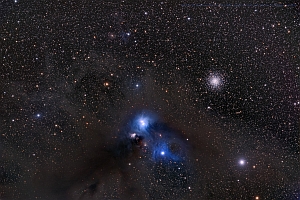Corona Australis is the topic of Part #7 of our image presentation, where we want to share the results from our astrophotography-trip to the Hacienda Los Andes in Chile.
Corona Australis (CrA) is a small constellation in the Southern Celestial Hemisphere, bordered by Sagittarius (Sgr) to the north, Scorpius (Sco) to the west, Telescopium (Tel) to the south, and Ara (Ara) to the southwest. It's Latin name means "southern crown" and it is the southern counterpart of Corona Borealis, the northern crown.
In the nothern part of the constellation we can find the Corona Australis Molecular Cloud, a dark molecular cloud with many embedded reflection nebulae, including NGC 6726, NGC 6727, NGC 6729 and IC 4812.
Sandqvist & Lindroos 42 (SLDN 42) is the beautiful dark cloud at the left edge of NGC 6726. A much more familiar object can be found in constellation Scorpius: The open star cluster M 6 (Butterfly Cluster) with a diameter of about 12 light years and a visual magnitude of about 4.2.
Another well known object is M 8 the Lagoon Nebula which is located in constellation Sgittarius. It is classified as an emission nebula and as an H II region. The Lagoon Nebula is one of only two star-forming nebulae which is faintly visible to the naked eye from the mid-northern latitudes. It's distance from earth is estimated between 4,000 - 6,000 light years an spans about 90' by 40' which equals a dimension of 110 by 50 light years. As many other nebulae it appears pink in color images but gray to the human eye (through binoculars or telescope).
Our series of constellation wide field images starts with an overview of the area of constellation Corona Australis (CrA). The next image shows the area of the well known constellation Scorpius (Sco) with it's brightest star Antares (Alpha Scorpii). And the last image shows the area of constellation Sagittarius (Sgr). As seen from the northern hemisphere, the constellation's brighter stars form an easily recognizable asterism known as the Teapot. Mentionable is the fact that Alpha Sagitarii with a magnitude of only 3.96 is not the brightest star of the constellation. Instead the brightest star is Epsilon Sagitarii at a magnitude of 1.85.
"Another great night" is the title of the following video made by our timelapse photographer Justin Kabaus. First some clouds are passing by, but then the sky clears up and you can enjoy the beauty of the Milky Way, the Magellanic Clouds and finally the sunrise in the morning:









